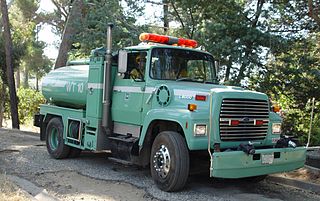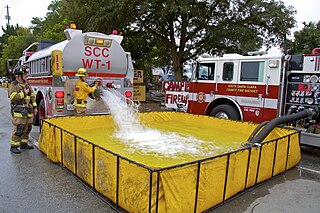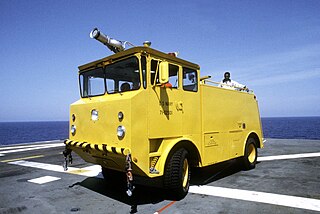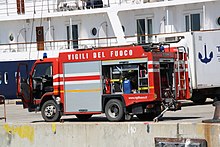
A fire engine or fire truck is a vehicle, usually a specially-designed or modified truck, that functions as a firefighting apparatus. The primary purposes of a fire engine include transporting firefighters and water to an incident as well as carrying equipment for firefighting operations in a fire drill. Some fire engines have specialized functions, such as wildfire suppression and aircraft rescue and firefighting, and may also carry equipment for technical rescue.
Firefighting jargon includes a diverse lexicon of both common and idiosyncratic terms. One problem that exists in trying to create a list such as this is that much of the terminology used by a particular department is specifically defined in their particular standing operating procedures, such that two departments may have completely different terms for the same thing. For example, depending on whom one asks, a safety team may be referred to as a standby, a RIT or RIG or RIC, or a FAST. Furthermore, a department may change a definition within its SOP, such that one year it may be RIT, and the next RIG or RIC.
This glossary of wildfire terms is a list of definitions of terms and concepts relevant to wildfires and wildland firefighting. Except where noted, terms have largely been sourced from a 1998 Fireline Handbook transcribed for a Conflict 21 counter-terrorism studies website by the Air National Guard.
This is a glossary of firefighting equipment.

Pierce Manufacturing is a U.S. company based in Appleton, Wisconsin that manufactures customized fire and rescue apparatus. A wholly owned subsidiary of Oshkosh Corporation, Pierce was acquired in 1996. It is currently one of the largest fire apparatus company in the US. The company was founded in 1913 by Humphrey Pierce and his son Dudley as the Pierce Auto Body Works Inc., and concentrated on building custom truck bodies for the Ford Model T. The first production facility was designed in 1917 and enlarged in 1918 by architect Wallace W. DeLong. From the 1960s to the early 1980s, Pierce was primarily known for building custom bodies on commercial and other manufacturer's custom chassis, and was considered an original equipment manufacturer (OEM).

A rescue vehicle is a specialised vehicle designed to transport and provide the equipment necessary for technical rescue. Vehicles carry an array of special equipment such as the jaws of life, wooden cribbing, generators, winches, hi-lift jacks, cranes, cutting torches, circular saws and other forms of heavy equipment unavailable on standard trucks. This capability differentiates them from traditional pumper trucks or ladder trucks designed primarily to carry firefighters and their entry gear as well as on-board water tanks, hoses and equipment for fire extinguishing and light rescue. Most rescue vehicles lack on-board water tanks and pumping gear, owing to their specialized role. A rescue vehicle is typically operated by a rescue squad, but in some areas it may be integrated with emergency medical services or fire departments.

Palm Beach County Fire Rescue (PBCFR) is one of the largest fire departments in the state of Florida. With 52 stations, Palm Beach County Fire Rescue provides fire protection, Advanced Life Support, emergency medical services, technical rescue, hazardous materials' mitigation, aircraft rescue/firefighting, fire investigation, and 911 dispatching for unincorporated parts of Palm Beach County, Florida as well as 19 cities under contract.

A wildland fire engine or brush truck is a fire engine specifically designed to assist in fighting wildfires by transporting firefighters to the scene and providing them with access to the fire, along with water or other equipment. There are multiple types of wildfire apparatus which are used in different scenarios. According to the U.S. National Fire Protection Association, if the apparatus will be used primarily for outdoor and wildland responses, then it is to be considered a wildland fire apparatus and must conform to NFPA 1906.

A wildland water tender is a specialized vehicle capable of bringing water, foam, or dry chemicals to fire trucks in the field that are engaged on the fireline. Water tenders have a large truck mounted tank that carries a minimum 1,000 gallons and up to 4,000 gallons of water. These vehicles are specifically designed for fire fighting often with four-wheel drive, rugged suspension and high wheel clearance for mountainous dirt road conditions. According to the National Fire Protection Association, if the apparatus will be used primarily for outdoor and wildland responses, then it is to be considered a wildland fire apparatus and must conform to NFPA 1906.

A compressed air foam system is used in firefighting to deliver fire retardant foam for the purpose of extinguishing a fire or protecting unburned areas.

An airport crash tender is a specialised fire engine designed for use in aircraft firefighting at aerodromes, airports, and military air bases.
The San Diego Fire-Rescue Department (SDFD) is an all-risk, all-hazards fire department, providing fire protection and emergency medical services to the city of San Diego, California, United States. The San Diego Fire-Rescue Department is the second-largest municipal fire department in the state of California, after Los Angeles and responds to nearly 162,000 calls per year. The San Diego Fire-Rescue Department covers 343 square miles of service area including 17 miles of coastline, with responsibility extending 3 miles offshore.

A fire extinguisher is a handheld active fire protection device usually filled with a dry or wet chemical used to extinguish or control small fires, often in emergencies. It is not intended for use on an out-of-control fire, such as one which has reached the ceiling, endangers the user, or otherwise requires the equipment, personnel, resources or expertise of a fire brigade. Typically, a fire extinguisher consists of a hand-held cylindrical pressure vessel containing an agent that can be discharged to extinguish a fire. Fire extinguishers manufactured with non-cylindrical pressure vessels also exist but are less common.
Firefighting is the act of extinguishing destructive fires. A firefighter fights these fires with the intent to prevent destruction of life, property and the environment. Firefighting is a highly technical profession, which requires years of training and education in order to become proficient. A fire can rapidly spread and endanger many lives; however, with modern firefighting techniques, catastrophe can usually be avoided. To help prevent fires from starting, a firefighter's duties include public education and conducting fire inspections. Because firefighters are often the first responders to victims in critical conditions, firefighters often also provide basic life support as emergency medical technicians or advanced life support as licensed paramedics. Firefighters make up one of the major emergency services, along with the emergency medical service, the police, and many others.

Flexible suction hose, not to be confused with hard suction hose in U.S., is a specific type of fire hose used in drafting operations, when a fire engine uses a vacuum to draw water from a portable water tank, pool, or other static water source. It is built to withstand vacuum, rather than pressure, abrasion, and heat. Conversely, hard suction is capable of withstanding up to 200 PSIG, as well as vacuum. In the United States, it is standard equipment according to the National Fire Protection Association standards for fire engines. It is used in both structural and wildland firefighting throughout the world, and is made in various diameters and connection types.

Fire services in the United Kingdom use a variety of fire appliances, which perform a wide range of general and specialised roles and fit into several distinct categories. Contemporary fire appliances carry a multitude of equipment and firefighting media to deal with different types of emergencies ranging from fires, rescues, vehicle extrication, floods, salvage, casualty and trauma care.

A portable water tank is a temporary collapsible tank designed for the reserve storage of water in firefighting, emergency relief, and military applications. These tanks can be either supported or unsupported. The supported tanks have a steel or aluminum frame and range in size from 600 to 5,000 US gallons or larger by custom design. Portable water tanks are also unsupported such as self-supporting tanks, blivets and pillow or bladder tanks and are available in sizes ranging from 100 US gallons up to 80,000 US gallons.
Wildfire suppression equipment and personnel is part of the science of fire fighting focusing on the use of specialized equipment, training and tactics to effectively control, surround and eventually extinguish a natural cover fire. There are several specially designed tools that through their function and user training, perform specialized tasks that are specific to natural cover firefighting. This is used together in conjunction with the general understanding of the behavior of fire to form a viable plan of attack.

Firefighting in the United States dates back to the earliest European colonies in the Americas. Early firefighters were simply community members who would respond to neighborhood fires with buckets. The first dedicated volunteer fire brigade was established in 1736 in Philadelphia. These volunteer companies were often paid by insurance companies in return for protecting their clients.

The Oshkosh MB-5 is a specialized aircraft rescue and firefighting (ARFF) vehicle built by Oshkosh Corporation for putting out fires on-board aircraft carriers. It was designed for rapid deployment of multiple firefighting media by a crew of 4, with a relatively compact design. However, What set this truck apart from other ARFF vehicles of the time was its ability to pump water while moving. This feature, along with its powerful 10.7 L Caterpillar diesel engine and four-wheel drive, made the MB-5 a staple of US military firefighting. It could be seen on US aircraft carriers and airbases both during and after the Vietnam War, continuing service for almost a decade after production of the truck stopped in late 1971 (unconfirmed).
















